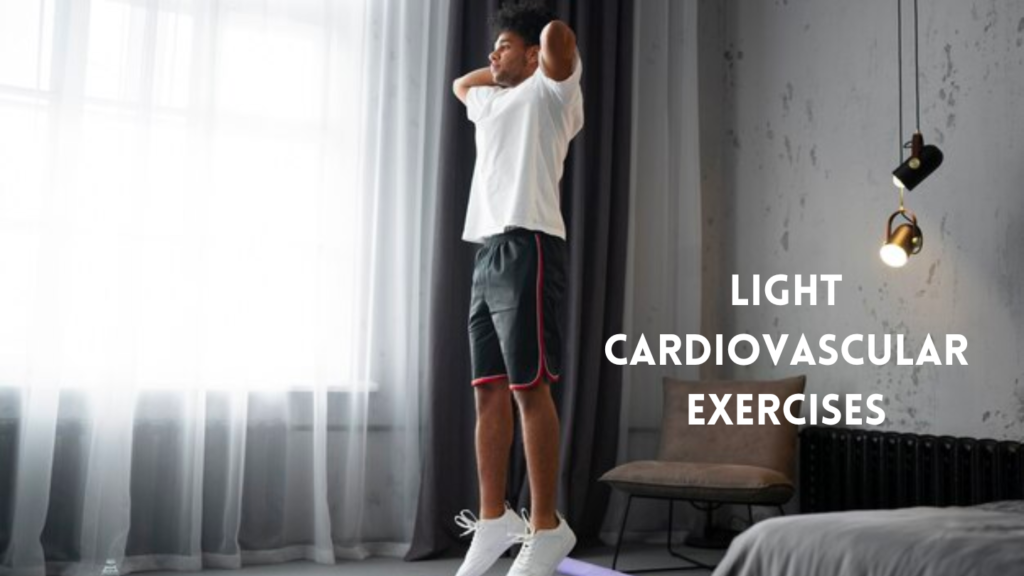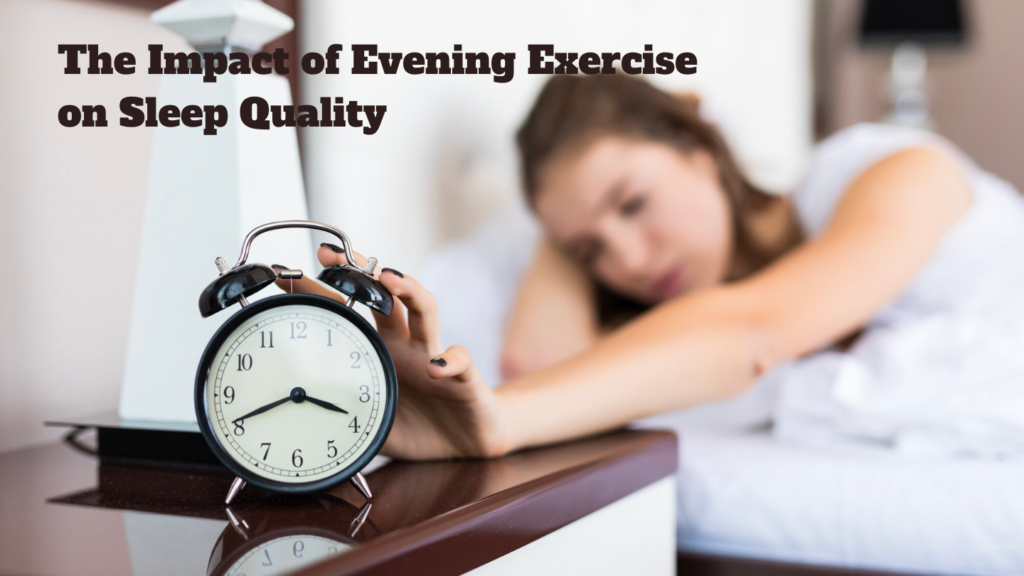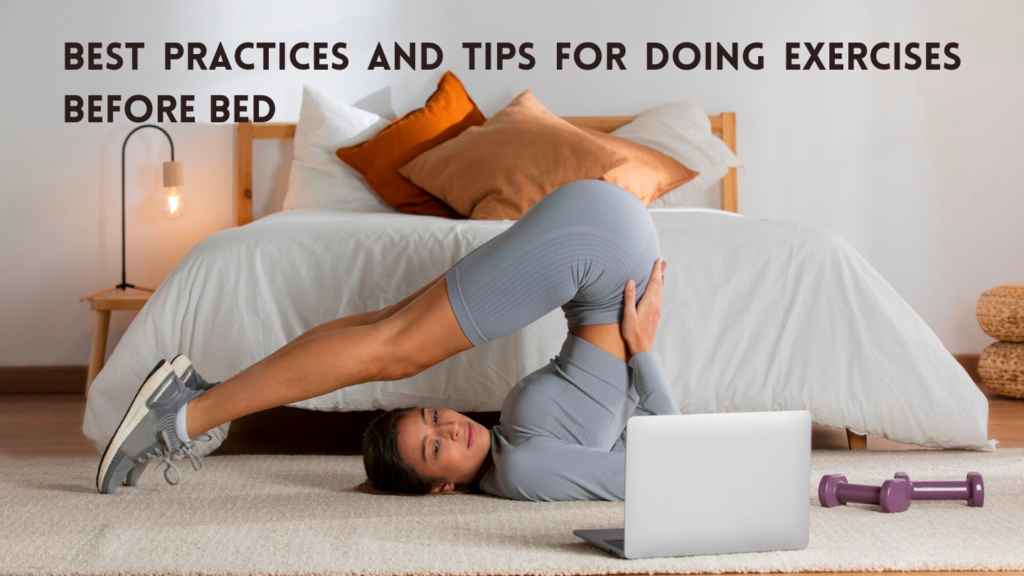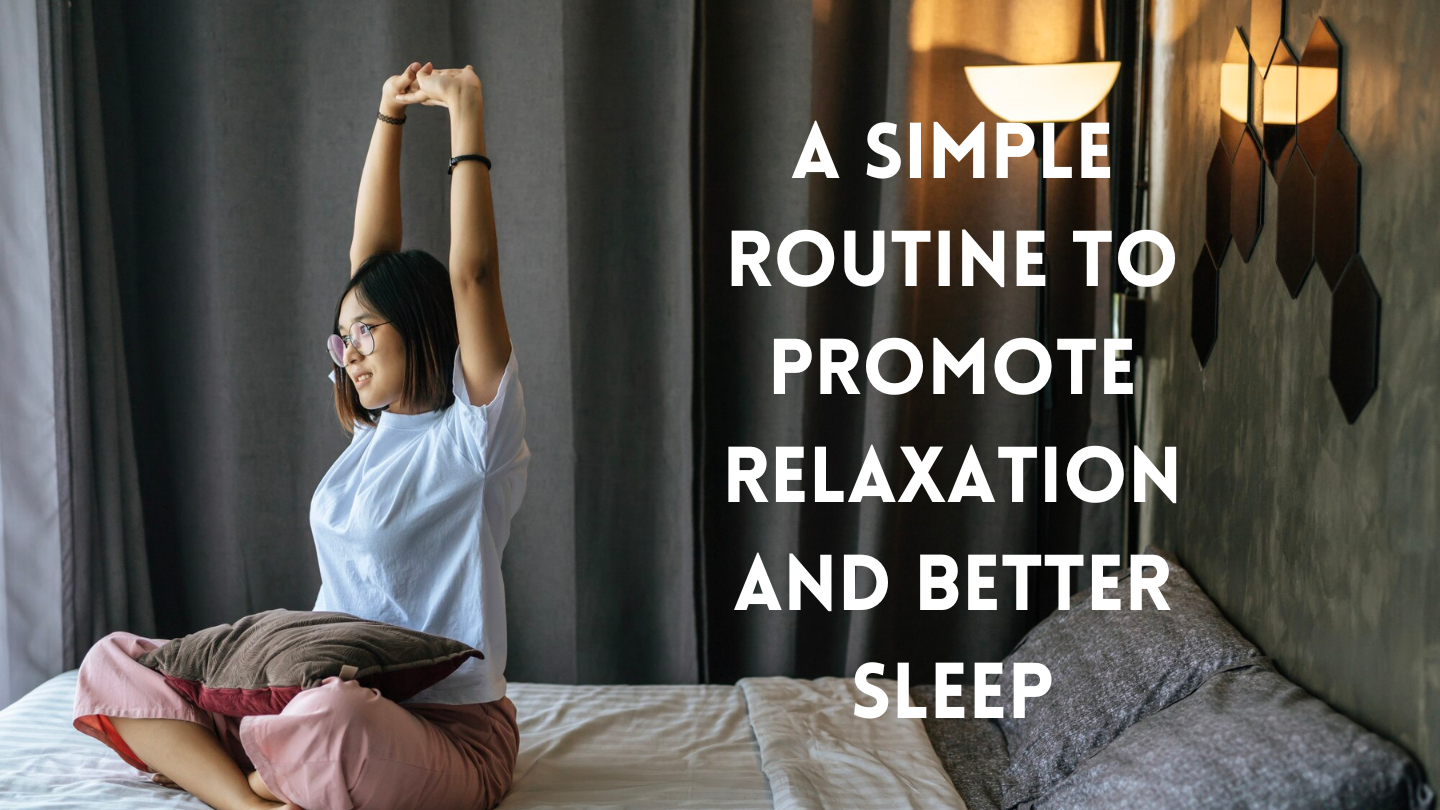Introduction to Exercises Before Sleep
In our modern, rapidly-moving society, carving out time for exercise can often feel like an uphill battle. Despite this, making physical activity a part of your everyday routine – even before going to bed – can provide a multitude of advantages. In this insightful piece, we delve into the importance of pre-bedtime exercise and its potential to lower blood pressure.
Understanding the Importance of Exercise Before Bed
When it comes to exercise, most people think of morning routines or hitting the gym during the day. But have you ever considered working out before going to bed? This seemingly unconventional idea is actually gaining traction, thanks to its potential positive effects. So let’s explore the significance of bedtime exercise and discover why it could be a game-changer for your overall health and well-being.
Benefits of Exercise Before Bed
Improved Sleep Quality
Contrary to the belief that exercising before bed disrupts sleep, research suggests that moderate physical activity can actually enhance sleep quality. Engaging in calming exercises helps reduce stress and tension accumulated throughout the day, preparing your body for a restful night’s sleep.
Stress Reduction
Bedtime workouts serve as an effective way to unwind after a hectic day. Physical activity prompts the release of endorphins, which are neurotransmitters known for their mood-boosting properties. By reducing stress levels, bedtime exercise sets the stage for a more relaxed and peaceful sleep.
Metabolism Boost
Exercising before bed can also rev up your metabolism. While intense workouts are not recommended close to bedtime, engaging in light to moderate activity can stimulate metabolic processes, aiding digestion and calorie burning even during sleep.
Types of Exercises Suitable for Bedtime

Yoga and Stretching
Experience ultimate relaxation before bed with yoga and stretching routines. These soothing exercises improve flexibility, relieve muscle tension, and encourage deep breathing, fostering a serene and peaceful mind.
Light Cardio
Simple cardio exercises like walking or cycling at your leisure can help keep your heart rate in check and help you relax. Try to do activities that slightly increase your heart rate without pushing yourself too hard or causing an adrenaline rush.
Breathing Exercises
Incorporating breathing exercises into your bedtime routine can signal to your body that it’s time to unwind. Techniques like diaphragmatic breathing or progressive muscle relaxation can soothe the nervous system and induce a sense of tranquillity conducive to sleep.
Timing and Frequency
Determining the optimal time for bedtime exercise depends on individual preferences and schedules. However, it’s generally advisable to avoid vigorous workouts too close to bedtime, as they may interfere with the body’s natural wind-down process. Aim for at least 30 minutes to an hour before bedtime to allow your body to relax.
Tips for Effective Bedtime Workouts

Listen to Your Body
Pay attention to how your body responds to evening exercise. If you find that it invigorates rather than relaxes you, consider adjusting the intensity or timing of your workouts.
Create a Relaxing Environment
Set the stage for restorative sleep by creating a calming environment in your bedroom. Dim the lights, minimise screen time, and engage in activities that promote relaxation before and after your bedtime workout.
Avoid Intense Workouts
Maximise the effectiveness of your workouts by reserving high-intensity sessions for earlier in the day when your vitality is at its peak. To ensure a restful night’s sleep, consider soothing, low-impact activities that help your body and mind wind down.
Addressing Concerns and Myths
Disruption of Sleep
Contrary to popular belief, moderate exercise before bed can actually promote better sleep quality by reducing stress and tension accumulated throughout the day.
Increased Energy Levels
While exercise does temporarily increase energy levels due to the release of endorphins, bedtime workouts are designed to facilitate relaxation and prepare the body for sleep, not to induce wakefulness.
Safety Concerns
Considering specific health conditions or sleep disorders, it’s advisable to consult a healthcare professional prior to initiating any bedtime exercise regimen. This step ensures both safety and effectiveness in your routine.
ALSO READ : What are the 5 benefits of physical health?
Scientific Insights on Exercise and Sleep
Research suggests that exercise can influence circadian rhythms and promote the release of hormones such as melatonin, which regulates sleep-wake cycles. By aligning physical activity with the body’s natural rhythms, bedtime exercise can enhance overall sleep quality and duration.
Personal Experiences and Testimonials
Many individuals have reported positive experiences with bedtime exercise, citing improved sleep quality, reduced stress, and enhanced well-being as key benefits. Real-life testimonials serve as compelling evidence of the effectiveness of incorporating exercise into bedtime routines.
Is it okay to exercise vigorously before bed?
Vigorous exercise too close to bedtime may interfere with sleep, so it’s best to opt for gentle activities.
How long before bed should I exercise?
Aim for at least 30 minutes to an hour before bedtime to allow your body to wind down effectively.
Can bedtime exercise help with insomnia?
Yes, incorporating calming exercises into your bedtime routine can help alleviate symptoms of insomnia and promote better sleep.
Are there specific exercises I should avoid before bed?
Avoid high-intensity workouts and activities that may cause adrenaline spikes, as
They can hinder relaxation and sleep.
Should I consult a doctor before starting a bedtime exercise routine?
If you have underlying health conditions or sleep disorders, it’s advisable to consult a healthcare professional before implementing a new exercise regimen.
Types of Exercises Suitable for Before Sleep

In the hustle and bustle of modern life, finding time for exercise can be challenging. However, carving out a few minutes for physical activity before bedtime can offer numerous benefits. This article explores the types of exercises suitable for before sleep and how they can contribute to better overall health and improved sleep quality.
Understanding the Importance of Pre-Sleep Exercises
Before diving into specific exercises, it’s crucial to understand why engaging in physical activity before sleep matters. Pre-sleep exercises can help relax the body and mind, alleviate stress and tension accumulated throughout the day, and prepare the body for a restful night’s sleep.
Light Cardiovascular Exercises

Benefits of Light Cardiovascular Exercises
Engaging in light cardiovascular exercises before bed can elevate the heart rate slightly, promoting blood circulation and increasing body temperature. This can aid in easing muscle tension and promoting relaxation, making it easier to transition into sleep.
Examples of Light Cardiovascular Exercises
Examples of light cardiovascular exercises suitable for before sleep include brisk walking, gentle cycling, or a short jog. These activities shouldn’t be overly strenuous but should be enough to get the heart pumping and the blood flowing.
Yoga and Stretching
Benefits of Yoga and Stretching
In the realm of wellness, yoga and stretching exercises reign supreme, celebrated for their profound capacity to induce relaxation, enhance flexibility, and cultivate mindfulness. Engaging in a repertoire of serene yoga poses and soothing stretches prior to bedtime serves as a conduit for dissipating bodily tension, pacifying the tumult of the mind, and heralding the onset of tranquillity, coaxing the body gently into a state of repose.
Examples of Yoga Poses and Stretching Exercises
Enhancing your pre-sleep routine with yoga can work wonders for a restful night. Among the array of poses, consider including the soothing Child’s Pose, the calming Forward Fold, and the rejuvenating Legs-Up-The-Wall Pose. By integrating gentle stretches targeting key muscle groups like the neck, shoulders, and legs, you invite deeper relaxation and foster improved sleep patterns.
Breathing Exercises

Benefits of Breathing Exercises
Breathing exercises, such as diaphragmatic breathing and progressive muscle relaxation, can be powerful tools for promoting relaxation and reducing stress and anxiety levels before sleep. These techniques help calm the nervous system, slow down the heart rate, and quiet the mind, making it easier to drift off into a peaceful slumber.
Different Types of Breathing Techniques
Delving into the realm of pre-slumber rituals, an effective technique emerges: the 4-7-8 method. Here’s how it unfolds: Inhale deeply, counting to 4; pause, holding your breath steady for a count of 7; then, release slowly, exhaling to the count of 8. An alternative avenue lies in the depths of deep belly breathing, a practice that directs attention to the core, fostering relaxation and the alleviation of stress.
Creating a Pre-Sleep Exercise Routine
To reap the full benefits of pre-sleep exercises, consider creating a simple and consistent routine that you can follow each night. This routine can include a combination of light cardiovascular exercises, yoga or stretching, and breathing exercises tailored to your preferences and physical abilities.
Tips for Incorporating Pre-Sleep Exercises into Your Routine
- Prepare your pre-sleep exercise regimen no less than sixty minutes prior to bedtime, granting your body ample time to ease into relaxation.
- Opt for pursuits that bring you joy and induce a sense of calmness, enhancing the sustainability of your routine.
- Steer clear of stimulating engagements like rigorous workouts or screen indulgence right before retiring for the night, as they may disrupt your ability to drift into slumber.
Avoiding Intense Workouts Before Bed
While exercise is beneficial for overall health, engaging in intense workouts before bed can have the opposite effect and make it harder to fall asleep. Intense physical activity raises the heart rate and body temperature, signalling to the body that it needs to stay alert rather than wind down for sleep.
ALSO READ : 5 types of apology languages to solve relationship conflicts
The Science Behind Pre-Sleep Exercises and Better Sleep
Studies indicate that participating in pre-sleep activities can effectively regulate circadian rhythms, enhance the quality of sleep, and shorten the duration required to transition into slumber. Engaging in physical exercises encourages the secretion of endorphins, known as natural mood enhancers, thereby mitigating symptoms associated with insomnia and various sleep-related conditions.
Myths and Misconceptions About Pre-Sleep Exercises
Contrary to popular belief, exercising before bed does not necessarily disrupt sleep patterns. However, it’s essential to choose the right types of exercises and avoid vigorous activities close to bedtime to ensure a restful night’s sleep.
Understanding Your Body’s Limits
Listen to your body and respect its limits when engaging in pre-sleep exercises. If you experience pain or discomfort, modify the exercises or consult with a healthcare professional for personalised advice.
Consulting with a Healthcare Professional
For those with preexisting health conditions or reservations about integrating pre-sleep exercises into their regimen, consulting a healthcare expert is recommended. Such professionals can provide tailored advice considering your specific requirements and situation.
The Relationship Between Exercise and Decreasing Blood Pressure

The correlation connecting physical activity and the reduction of blood pressure stands as a firmly established fact within medical studies. As people pursue healthier ways of living, comprehending the impact of exercise on blood pressure assumes ever-growing importance. Within this piece, we explore the intricate dynamics between exercise and the decrement of blood pressure levels.
Understanding Blood Pressure
Before delving into the ramifications of physical activity, it’s paramount to grasp the significance of blood pressure. Blood pressure denotes the force exerted by the circulation of blood against the arterial walls. It comprises two distinct figures: systolic pressure, indicative of the pressure during heart contractions, and diastolic pressure, reflecting the pressure when the heart rests between contractions. Elevated blood pressure, commonly referred to as hypertension, can impose strain on the heart and inflict damage upon blood vessels, thereby precipitating severe health complications.
Effects of Sedentary Lifestyle on Blood Pressure
In our modern era, sedentary lifestyles have become pervasive, marked by minimal physical activity and often intertwined with elevated blood pressure levels. The absence of movement not only fosters weight gain but also undermines cardiovascular well-being and exacerbates stress levels. These cumulative effects gradually conspire to elevate blood pressure, posing significant health risks over time.
How Exercise Impacts Blood Pressure
Regular exercise offers a multitude of benefits for reducing blood pressure levels and improving overall health.
Cardiovascular Benefits: Aerobic exercises such as walking, jogging, cycling, and swimming promote heart health by enhancing circulation, strengthening the heart muscle, and reducing arterial stiffness.
Weight Management: Engaging in physical activity helps burn calories and maintain a healthy weight, reducing the risk of obesity-related hypertension.
Stress Reduction: Exercise triggers the release of endorphins, neurotransmitters that alleviate stress and improve mood. By combating stress, exercise indirectly contributes to lower blood pressure levels.
Types of Exercises for Blood Pressure Reduction
Various forms of exercise contribute to lowering blood pressure:
Aerobic Exercises: These activities increase heart rate and breathing, enhancing cardiovascular fitness and reducing blood pressure.
Strength Training: Resistance exercises like weightlifting or bodyweight exercises build muscle mass, which can help regulate blood pressure.
Flexibility and Balance Exercises: Practices like yoga and tai chi improve flexibility, balance, and circulation, contributing to overall cardiovascular health.
Recommended Exercise Guidelines
Health authorities recommend at least 150 minutes of moderate-intensity aerobic activity or 75 minutes of vigorous-intensity aerobic activity weekly, along with muscle-strengthening activities on two or more days per week.
Case Studies and Research Findings
An abundance of research underscores the effectiveness of regular exercise in reducing blood pressure. Take, for example, a study from 2019 featured in the Circulation journal by the American Heart Association, which revealed a marked decrease in the likelihood of hypertension with consistent physical activity.
Risks and Precautions
Engaging in physical activity typically offers safety and advantages; nonetheless, individuals grappling with hypertension ought to seek counsel from healthcare experts prior to embarking on a fresh exercise routine, particularly if other health issues are in the picture.
Incorporating Exercise into Daily Routine
Embracing physical activity as part of your everyday routine can be both effortless and delightful. Opting for a stroll rather than relying on transportation, choosing the stairs over the elevator, and engaging in recreational sports all contribute significantly to enhancing your daily mobility.
Monitoring Blood Pressure Changes
Monitoring blood pressure on a regular basis is instrumental in enabling individuals to keep tabs on their health trajectory and make necessary adjustments to their lifestyle choices. The advent of home blood pressure monitors not only provides unparalleled convenience but also serves as a catalyst for individuals to assume command over their well-being.
Lifestyle Modifications for Better Results
In addition to exercise, adopting a balanced diet rich in fruits, vegetables, lean proteins, and whole grains can further support blood pressure management.
Combining Exercise with Dietary Changes
Pairing exercise with dietary modifications, such as reducing sodium intake and limiting alcohol consumption, amplifies the benefits of a healthy lifestyle on blood pressure.
Addressing Common Concerns and Excuses
Many individuals cite time constraints or lack of motivation as barriers to regular exercise. By prioritising physical activity, setting achievable goals, and finding enjoyable activities, overcoming these obstacles becomes feasible.
Celebrating Success Stories
Highlighting success stories of individuals who have effectively lowered their blood pressure through exercise can inspire and motivate others to embark on their own health journeys.
Benefits of Performing Exercises Before Sleep
Contrary to popular belief, engaging in physical activity before bedtime can positively influence various aspects of your health. Understanding the potential advantages can motivate individuals to incorporate evening exercise routines into their daily lives.
The Impact of Evening Exercise on Sleep Quality

Hormonal Regulation
Engaging in physical activity prior to bedtime initiates the liberation of endorphins, those remarkable neurotransmitters renowned for diminishing stress levels and fostering a sense of tranquillity. Moreover, it catalyses the secretion of melatonin, the pivotal hormone orchestrating our sleep-wake patterns, thereby enhancing the overall quality of sleep experienced.
Body Temperature Regulation
Evening workouts elevate body temperature, promoting a post-exercise drop in temperature that mimics the body’s natural circadian rhythm. This decrease signals the body that it’s time to rest, facilitating faster sleep onset.
Boosting Metabolism Through Evening Workouts
Research indicates that engaging in physical activity prior to bedtime can elevate metabolic rate, resulting in heightened calorie expenditure and fat oxidation throughout the night. This phenomenon plays a pivotal role in weight regulation and overall metabolic well-being.
Improving Cognitive Function
In the realm of cognitive enhancement, engaging in regular evening exercise emerges as a potent catalyst. This habitual practice intertwines with cognitive function and the consolidation of memory, yielding remarkable outcomes. Through physical exertion, the intricate mechanisms within the brain awaken, prompting the liberation of brain-derived neurotrophic factor (BDNF). This pivotal protein orchestrates the proliferation and sustenance of brain cells, thereby amplifying cognitive prowess and fortifying memory reservoirs.
Reducing Stress and Anxiety
Engaging in physical activity before bedtime can alleviate symptoms of stress and anxiety by promoting the release of feel-good neurotransmitters and reducing levels of cortisol, the stress hormone. This relaxation effect prepares the body and mind for restorative sleep.
Promoting Muscle Recovery and Growth
Evening workouts provide an opportunity for muscle recovery and growth, as the body repairs and strengthens muscles during sleep. Incorporating resistance training exercises before bedtime can optimise muscle protein synthesis and facilitate muscle repair processes.
Enhancing Sleep Quality
Deep Sleep Promotion
Exercising before sleep increases the duration and intensity of deep sleep stages, which are essential for physical and mental restoration. Deep sleep facilitates tissue repair, hormone regulation, and memory consolidation, contributing to overall well-being.
Reducing Sleep Onset Latency
Individuals who exercise before sleep typically experience shorter sleep onset latency, or the time it takes to fall asleep. This can be attributed to the natural decrease in body temperature following physical activity, promoting relaxation and facilitating sleep initiation.
Addressing Common Concerns
Myth Debunking: Sleep Disruption
Despite common assumptions, engaging in physical activity before bedtime does not inherently disturb sleep rhythms. Studies actually suggest that engaging in moderate-intensity exercise during the evening can potentially improve the quality of sleep without inducing disruptions.
Appropriate Exercise Intensity
It’s essential to choose appropriate exercise intensity levels before bedtime. While moderate-intensity activities such as yoga, brisk walking, or cycling are generally well-tolerated, vigorous exercises may have a stimulating effect and should be avoided close to bedtime.
Best Exercises for Evening Routines
Incorporating a variety of exercises into your evening routine can target different muscle groups and promote overall fitness. Examples include strength training, flexibility exercises, aerobic activities, and relaxation techniques like yoga and meditation.
Creating an Evening Exercise Routine
Enhancing the rewards of exercising pre-slumber involves a nuanced consideration of timing, duration, and intensity within your workout regimen. Moreover, emphasising post-workout hydration and nutrition emerges as pivotal in facilitating muscle recovery and revitalising depleted energy reserves.
Factors to Consider
Individuals with certain medical conditions or sleep disorders should consult healthcare professionals before implementing evening exercise routines. Additionally, listening to your body’s signals and adjusting your workout intensity and duration accordingly is crucial for preventing overexertion and injury.
Best Practices and Tips for Doing Exercises Before Bed

1. Introduction to Exercising Before Bed
In contemporary lifestyles, the practice of exercising before bedtime has gained traction among those aiming to enrich their holistic health. Despite the seeming contradiction of engaging in physical exertion prior to rest, this practice holds the potential to induce relaxation and elevate the sleep quality of numerous individuals.
2. Benefits of Doing Exercises Before Bed
Engaging in gentle exercises before bedtime offers a myriad of benefits. Not only does it help release tension accumulated throughout the day, but it also aids in stress reduction, promotes better circulation, and prepares the body for restorative sleep.
3. Types of Exercises Suitable for Bedtime
Stretching Exercises
Adding gentle stretching routines to your nightly rituals can ease muscle tension, improve flexibility, and prime you for a peaceful night’s rest.
Yoga Poses
Engaging in a session of yoga prior to bedtime holds a remarkable efficacy in soothing the mind and unwinding the body. Concentrate on embracing gentle, tranquil poses aimed at fostering profound breathwork and alleviating accumulated tension.
Low-Impact Cardio
Participating in gentle cardiovascular activities like brisk walking or cycling can mildly increase your heart rate while enhancing endorphin levels. This dual effect fosters a feeling of tranquillity and overall wellness.
4. Tips for Effective Bedtime Exercises
Time Management
Schedule your bedtime exercises at least an hour before sleep to allow your body to cool down gradually and signal to your brain that it’s time to unwind.
Proper Attire
Opt for comfortable clothing that allows for ease of movement and doesn’t restrict blood flow during your bedtime workout sessions.
Creating a Relaxing Environment
Set the mood for relaxation by dimming the lights, playing calming music, or practising deep breathing exercises before and after your bedtime exercises.
5. Common Mistakes to Avoid
Avoid engaging in vigorous or high-intensity workouts before bed, as they can elevate adrenaline levels and make it difficult to fall asleep. Additionally, refrain from consuming caffeine or heavy meals close to bedtime, as they can interfere with your ability to relax.
6. Impact of Bedtime Exercises on Sleep Quality
Research suggests that incorporating regular bedtime exercises into your routine can lead to improved sleep quality, reduced nighttime awakenings, and enhanced overall sleep efficiency.
7. Incorporating Mindfulness and Relaxation Techniques
Incorporate mindfulness and relaxation techniques, such as meditation or progressive muscle relaxation, into your bedtime routine to further promote relaxation and prepare your body for sleep.
8. Addressing Concerns About Exercising Before Bed
While some individuals may have concerns about exercising before bed disrupting their sleep patterns, many find that gentle, low-impact exercises can actually promote relaxation and improve sleep quality when done mindfully and in moderation.
9. The Importance of Consistency
Consistency is key when it comes to reaping the benefits of bedtime exercises. Make it a habit to incorporate gentle physical activity into your nightly routine to experience long-term improvements in sleep quality and overall well-being.
10. Listening to Your Body
Pay attention to how your body responds to bedtime exercises and adjust your routine accordingly. If you experience discomfort or difficulty sleeping after exercising before bed, consider modifying the intensity or timing of your workouts.
11. Expert Recommendations and Opinions
In the realm of health and fitness, numerous experts champion the merits of integrating bedtime exercises into your daily regimen. They extol the virtues of heightened sleep quality, diminished stress levels, and augmented overall well-being as pivotal benefits.
12. Testimonials and Success Stories
Numerous individuals have reported positive experiences with incorporating bedtime exercises into their nightly routines, noting significant improvements in sleep quality, mood, and overall well-being.
How to Incorporate Exercise into Your Evening Routine
Navigating the whirlwind of today’s rapid-paced lifestyle, carving out a slice of time for exercise emerges as a formidable challenge. Juggling myriad commitments and a bustling schedule, the mere thought of squeezing in a workout session appears daunting. Yet, weaving the fabric of exercise into your evening ritual stands as a potent solution, a gateway to perpetuating vitality and embracing a wholesome lifestyle. Within the confines of this discourse, we embark on a journey to unravel pragmatic methodologies, illuminating the path toward embracing evening exercise as an integral facet of your daily regimen.
Understanding the Importance of Evening Exercise
Dusk workouts yield a plethora of advantages for both body and mind. They serve as stress relievers, elevate the quality of sleep, rev up metabolism, and uplift one’s mood and vitality. Partaking in physical exertion during twilight hours facilitates relaxation post a hectic day, easing the journey into a tranquil night’s slumber.
Identifying Barriers to Evening Exercise
Embarking on your evening exercise regimen requires a proactive approach to identify and overcome potential hurdles that could impede your consistency. These hurdles often manifest as time constraints, fatigue, and waning motivation, all of which demand acknowledgment and strategic management before commencing your routine.
Time Constraints
Many people find it challenging to carve out time for exercise in the evening, especially after a busy day at work or caring for family members. However, by prioritising your health and well-being, you can make exercise a non-negotiable part of your daily routine.
Fatigue
Following a day brimming with activities, experiencing fatigue and depletion is entirely common. Yet, embracing physical exertion can effectively counteract weariness. It achieves this by enhancing blood circulation and unleashing endorphins, the innate uplifters of mood.
Lack of Motivation
Navigating the realm of motivation proves arduous, particularly amidst fatigue or stress. Discovering pursuits that ignite your passion and establishing realistic objectives serve as anchors, propelling your commitment and concentration throughout your fitness expedition.
Tips for Incorporating Exercise into Your Evening Routine
To successfully incorporate exercise into your evening routine, consider the following tips:
Setting Realistic Goals
Commence your fitness journey by establishing pragmatic and attainable goals that harmonise with your daily routine and personal preferences. Whether you opt for committing to a 30-minute exercise session thrice weekly or exploring novel workout classes, delineating precise objectives can bolster your commitment and consistency.
Choosing Enjoyable Activities
Discover physical pursuits that truly captivate you, be it embarking on a refreshing run, embracing the serenity of yoga sessions, or losing yourself in the rhythm of dancing to melodies close to your heart. Anticipating your exercise endeavours enhances the prospects of sustained commitment in the long haul.
Creating a Supportive Environment
Surround yourself with a supportive network of friends, family members, or workout buddies who can cheer you on and hold you accountable. Consider joining group fitness classes or online communities for added support and motivation.
Prioritising Rest and Recovery
Listen to your body and prioritise rest and recovery as part of your evening routine. Incorporate stretching, foam rolling, or relaxation techniques to help your muscles recover and prevent injury.
Creating a Structured Evening Exercise Plan
To ensure consistency and success with your evening exercise routine, consider creating a structured plan tailored to your needs and preferences.
Scheduling Workouts
Block out specific times in your evening schedule dedicated to exercise, treating them as non-negotiable appointments. Consistency is key, so aim to stick to your scheduled workouts as much as possible.
Mixing Up Activities
Enhance the allure and dynamism of your workout routine by infusing it with a diverse array of activities and exercises. Experiment with interchanging cardio sessions, strength training regimens, and flexibility exercises to continually stimulate your physique and stave off monotony.
Incorporating Flexibility
Embrace flexibility in your exercise regimen and refrain from being overly critical if circumstances deviate from your expectations. The journey of life is marked by its unpredictability; thus, remain open to adaptation and willing to tweak your workout routines as the need arises.
Overcoming Common Challenges
As you embark on your evening exercise journey, you may encounter various challenges along the way. Here are some tips for overcoming common obstacles:
Overcoming Procrastination
Overcome the grip of procrastination by fragmenting your workouts into bite-sized, achievable segments. Allocate a mere five minutes and pledge to initiate your exercise routine. As momentum builds, you’ll discover a reservoir of motivation propelling you forward.
Dealing with Busy Schedules
In the whirlwind of your bustling evenings, contemplate incorporating brief, high-impact fitness sessions that yield optimal outcomes within a concise timeframe. Merely dedicating 20-30 minutes to physical activity can yield profound enhancements in your holistic health and vitality.
Combating Fatigue
If you find yourself fatigued or lacking in energy, consider embracing mild exercises like taking a leisurely stroll, engaging in soothing stretches, or practising calming yoga. Tune into your body’s signals and select pursuits that promote a sense of renewal and invigoration.
Maximising the Benefits of Evening Exercise
By making evening exercise a regular part of your routine, you can maximise its numerous benefits, including:
- Improved Sleep Quality: Engage in regular physical activity to fine-tune your sleep patterns, paving the way for deeper, more revitalising rest.
- Stress Reduction: Embrace movement as it triggers the release of endorphins, your body’s natural stress fighters, alleviating tension and anxiety.
- Boosted Metabolism: By incorporating consistent exercise into your routine, you ignite your metabolism, torching calories and bolstering your weight management efforts for improved overall well-being.
- Enhanced Mood and Energy Levels: Exercise acts as a catalyst for the production of feel-good neurotransmitters such as serotonin and dopamine, amplifying your mood and energy reserves.
Avoiding Strenuous Activities Close to Bedtime
In the hustle and bustle of modern life, sleep often takes a backseat to other priorities. However, the quality of our sleep profoundly affects our overall well-being. One crucial aspect of promoting better sleep is avoiding strenuous activities close to bedtime.
Understanding the Importance of Sleep
Why Sleep Matters
Slumber isn’t just a passive rest phase; it stands as a cornerstone of our biological imperatives, crucial for upholding both our physical vitality and mental equilibrium. Sufficient sleep underpins cognitive prowess, emotional stability, and fortifies our immune resilience.
The Science Behind Sleep
Slumber isn’t just a passive rest phase; it stands as a cornerstone of our biological imperatives, crucial for upholding both our physical vitality and mental equilibrium. Sufficient sleep underpins cognitive prowess, emotional stability, and fortifies our immune resilience.
Effects of Strenuous Activities Before Bed
Impact on Sleep Quality
Participating in vigorous exercise or mentally stimulating activities close to bedtime can increase alertness and make it challenging to unwind. This heightened state of arousal makes it harder to transition into a restful sleep state.
Disruption of Circadian Rhythm
Strenuous activities trigger the release of stress hormones like cortisol, which can interfere with the body’s natural wind-down process. This disruption to our circadian rhythm can lead to difficulty falling asleep and fragmented sleep patterns.
Tips for Avoiding Strenuous Activities Before Bed
Establishing a Relaxing Routine
Establishing a serene pre-sleep ritual is key to promoting your body and mind to ease into relaxation mode. Consider indulging in tranquil activities such as immersing yourself in a captivating book, indulging in a soothing warm bath, or engaging in mindfulness exercises like deep breathing.
Practising Mindfulness and Meditation
Engage in mindfulness or meditation practices to quiet the mind and reduce stress levels before bedtime. Mindful breathing exercises can help promote relaxation and prepare the body for sleep.
Engaging in Light Stretching or Yoga
In the realm of soothing the body and fostering tranquillity, gentle stretching or yoga poses emerge as stalwart allies. By immersing oneself in deliberate, unhurried movements, individuals can coax their bodies into embracing flexibility and shedding the shackles of muscular tension.
Creating a Sleep-Friendly Environment
Optimal Bedroom Conditions
Transform your bedroom into a sanctuary for restful sleep by embracing darkness, serenity, and a soothing coolness. Prioritise a plush mattress and pillows that cradle and align your spine for optimal comfort and support.
Limiting Screen Time
Avoid exposure to electronic devices like smartphones, tablets, and computers before bedtime. The blue light emitted by these devices can suppress the production of melatonin, the hormone responsible for regulating sleep-wake cycles.
Dietary Considerations
Foods to Avoid Before Bed
Avoid indulging in heavy, decadent meals, consuming caffeine, or partaking in alcohol during the hours preceding your bedtime. These substances have the potential to disturb your natural sleep rhythms and prompt unwanted awakenings throughout the night.
Promoting Better Sleep with Nutrition
Choose sleep-promoting foods rich in tryptophan, magnesium, and complex carbohydrates. Incorporate foods like turkey, nuts, seeds, and whole grains into your evening meals to support healthy sleep.
The Role of Exercise in Sleep
Timing of Exercise
Engage in regular physical activity, but aim to complete vigorous workouts at least three hours before bedtime. Allow sufficient time for your body to cool down and relax before attempting to sleep.
Types of Exercise for Better Sleep
Consider engaging in activities such as tranquil yoga sessions, leisurely strolls, or refreshing swims during the twilight. These moderate exercises offer a means to alleviate stress and foster tranquillity without overwhelming the body.
Understanding Individual Needs
Personalising Sleep Strategies
Embark on a journey of sleep exploration, delving into various strategies to unearth the perfect fit for your needs. Capture your nocturnal adventures in a sleep diary, meticulously logging habits, and scrutinising the evolving landscape of your sleep quality.
Seeking Professional Advice
If you continue to struggle with sleep despite making lifestyle changes, consider consulting a healthcare professional or sleep specialist. They can help identify underlying sleep disorders or provide personalised recommendations for improving sleep quality.
Consulting with a Healthcare Professional
Amidst the whirlwind pace of modern life, the significance of consulting with a healthcare professional has escalated dramatically. Whether for routine check-ups or the intricate management of chronic ailments, the counsel of a seasoned healthcare provider stands as a cornerstone in preserving one’s health and fostering overall well-being.
Importance of Seeking Healthcare Advice
The first step in taking charge of your health is acknowledging the importance of seeking healthcare advice. Healthcare professionals possess the knowledge, expertise, and experience necessary to address a wide range of medical concerns, from minor ailments to serious illnesses. By consulting with a healthcare professional, individuals can receive personalised recommendations tailored to their unique health needs.
Choosing the Right Healthcare Professional
Selecting the right healthcare professional is crucial for receiving quality care. Whether it’s a primary care physician, specialist, or allied healthcare provider, individuals should consider factors such as credentials, experience, and compatibility. Building a trusting relationship with your healthcare provider fosters open communication and promotes collaborative decision-making.
Preparing for a Consultation
Prior to a consultation, it’s helpful to prepare relevant information, including medical history, current medications, and symptoms. Organising questions and concerns ensures that nothing is overlooked during the appointment. Additionally, bringing along a trusted companion can provide support and help remember important details discussed during the consultation.
During the Consultation
In the realm of consultations, active engagement stands as the cornerstone for optimising the advantages of the visit. It’s imperative for patients to harbour a sense of empowerment, encouraging them to articulate their worries, pose inquiries, and pursue elucidation regarding medical suggestions. Healthcare providers value patients who exhibit an active involvement in their well-being, demonstrating a readiness to partake in substantive dialogues concerning treatment modalities and preventative strategies.
Asking Relevant Questions
Effective communication during a healthcare consultation requires asking pertinent questions. It is crucial for patients to feel at ease when seeking clarification on medical terminology, treatment choices, and potential adverse reactions. By posing well-informed inquiries, individuals can enhance their comprehension of their health condition and actively engage in the decision-making process.
Understanding Medical Jargon
In the realm of healthcare, professionals frequently employ specialised medical terminology that might seem unfamiliar to patients. Establishing open communication channels with your healthcare provider and actively seeking clarifications for unfamiliar terms is paramount. Proficiency in medical jargon not only enriches patient understanding but also streamlines the process of making well-informed decisions regarding treatment options and healthcare guidance.
Active Participation in Decision Making
Empowering patients to truly engage in decision-making processes is paramount for taking control of their well-being. Within the realm of healthcare, professionals highly esteem the insights provided by patients, fostering environments ripe for collaborative dialogues aimed at crafting treatment strategies and defining health objectives. Through active involvement in decision-making, individuals are poised to make discerning choices that resonate with their core beliefs and personal inclinations.
Following Up After the Consultation
Following up after a consultation is an essential component of continuity of care. Patients should adhere to recommended follow-up appointments, diagnostic tests, and treatment plans outlined by their healthcare provider. Regular communication with healthcare professionals ensures that any changes in health status are promptly addressed and managed effectively.
Building a Trusting Relationship
Building a trusting relationship with your healthcare provider is foundational to quality healthcare delivery. Trust enables open communication, fosters mutual respect, and promotes patient-centred care. By establishing a strong rapport with your healthcare team, you can navigate healthcare decisions with confidence and peace of mind.
Benefits of Regular Check-Ups
In the realm of healthcare, regular check-ups stand as crucial sentinels guarding against potential health threats and unforeseen ailments. Through routine screenings, timely immunizations, and comprehensive health assessments, individuals can uncover latent risk factors and address them proactively, preventing the escalation of minor concerns into grave medical conditions. By prioritising preventive care, individuals pave the way towards enhanced well-being and a more fulfilling existence.
Integrating Lifestyle Changes
In the realm of healthcare, experts continually stress the pivotal role of lifestyle adjustments in fostering holistic health and a sense of wellness. Transitioning from dietary alterations and physical activity regimens to effective stress coping mechanisms, embedding wholesome practices into everyday routines emerges as a cornerstone for fostering enduring health benefits. Through a deliberate focus on self-nurturance and holistic well-being, individuals can mitigate the likelihood of chronic ailments while amplifying their overall quality of life.
Overcoming Barriers to Consulting
In the realm of healthcare, engaging with healthcare professionals stands as a pivotal step. Yet, individuals often face multifaceted hurdles that impede their pursuit of medical assistance. These obstacles span financial limitations, restricted entry to healthcare provisions, and deeply ingrained cultural convictions. It becomes imperative to actively confront these impediments and champion the cause of universal healthcare accessibility, ensuring equitable healthcare provisions for every individual.
Telemedicine and Remote Consultations
Advancements in technology have revolutionised healthcare delivery through telemedicine and remote consultations. Virtual appointments offer convenience, flexibility, and accessibility for patients, particularly those in rural or underserved areas. Telemedicine facilitates timely access to healthcare services and enables patients to consult with healthcare professionals from the comfort of their homes.
Conclusion: Empowering Healthcare Decisions
In summary, seeking guidance from a healthcare expert constitutes a proactive measure aimed at sustaining peak health and wellness. Through the deliberate emphasis on routine health assessments, active involvement in healthcare determinations, and the cultivation of trusting bonds with healthcare professionals, individuals empower themselves to manage their well-being effectively and make judicious decisions conducive to their holistic welfare.




